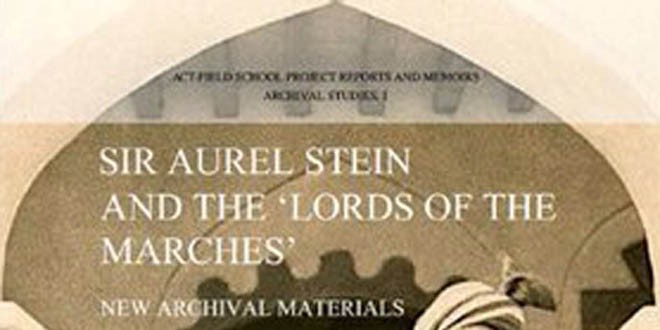
Sir Aurel Stein and the ‘lords of marches’: new archival materials by Luca Maria Olivieri is a new addition to the historiography of Indo-Pakistani archaeology

Investigations in the history of archaeology have been gaining more and more attention, across the world, due to multiple reasons. Two principal scholarly approaches -- internalism and externalism -- have influenced these historiographical considerations. The former posits in the validity of the ‘cumulative knowledge’ and tries to explore ‘objective truth’ about socio-cultural and natural phenomena. Contrarily, the latter situates ‘knowledge production activity’ in a wider socio-political context which results in subjective understanding.
The colonial archaeology of British India has also recently been approached from various theoretical standpoints. And Sir Aurel Stein and the ‘lords of marches’: new archival materials by Luca Maria Olivieri is a new addition to the historiography of Indo-Pakistani archaeology.
As is obvious from the title, the book presents archival research and sheds great light on some rather obscure issues of colonial archaeology of Gandhara. It comprises four main parts. The first part includes, as is common to all research works, ‘list of illustrations’, ‘foreword’, ‘list of abbreviations’ and ‘editorial notes’. The following part, in addition to a comprehensive ‘introduction’, presents a ‘catalogue’ in summarised form of all the archival documents in sequence and chronological order. It is followed by a detailed commentary of the author giving nuanced explanations and analysis from a historical and contextual point of view about the documents.
The third part of the book deals with seven appendices while the last one is all about different types of indexes (such as of names, places and typology of documents), references and sample photographic documentation of the documents.
Sir Aurel Stein and the ‘lords of marches’ emerged from cataloguing the pre-1947 documents at the Malakand Fort, Khyber-Pakhtunkhwa. Among the material, three folders containing 348 documents and spanning the period between 1895 and 1937 concerning archaeological matters and themes were isolated for further detailed analysis.
All the documents have been categorised by the author as ‘Endorsement Letters, Circulars, Notifications . . . demi-official Letters . . . notes, generally handwritten. . . ’. All this material tells the story of the beginning and development of archaeological activity in the ex-state of Swat (1917-69) and Malakand Agency. A number of famous scholars such as A. Caddy, A. Foucher, L. A. Waddell and A. Stein make, all through the book, their pioneering debut in the archaeology of the area. Similarly, the role of many important British political officers at Malakand has also been brought to the fore. Not less prominent than the colonial scholars and administrators are the rulers of the ex-Swat State, Miangul Abdul Wadud and Miangul Abdul Haq Jahanzeb. The enlightenment they have exhibited in the whole story clearly reflects in the book.
One of the issues the book is dealing with is the institutional and legal dimension of archaeological work in Malakand and Swat. Did the area, not making part of the settled provinces of British India, come under the jurisdiction of the Ancient Monuments Preservation Act 1904 and for that matter the Archaeological Survey of India? Diverse opinions and responses are found throughout the book based on personal interest or indifference of political officers stationed at Malakand.
Likewise, the issue of illegal digging and trafficking in antiquities as well as concerns for protection make another fascinating feature of the book. Such things have been rather related by the author to the overall archaeological context of the time in his commentaries.
Another important matter from a historical point of view is surfacing of the long forgotten story of Caddy’s archaeological expedition to Swat-Malakand. Caddy was a painter, photographer and antiquarian. Initially, he remained associated in different capacities with the Government of Bengal. Later on, Caddy busied himself in different projects as a painter and antiquarian. And it was in this context that Secretary to the Bengal Government commissioned him to Swat and Gandhara to make a collection of Gandhara art for the Calcutta Museum. He reached Swat in 1896 and, among other activities such as photography and landscape survey, excavated the world-wide famous Buddhist site of Loriyan. The collection is lying in the Calcutta Museum and is widely known for its artistic sophistication.
The original report which Caddy had submitted to the government was unavailable to scholars till its recent discovery in the Malakand Fort material. It is carefully studied by Kurt Behrendt and makes part -- as appendix 4 -- of Sir Aurel Stein and the ‘lords of marches’. Furthermore, a catalogue of the Gandhara collection at Malakand Fort has been prepared by P. Brancaccio as appendix 5.
Another valuable addition the book makes to our scholarship is with regard to Aurel Stein’s archaeological explorations into Swat. His very first visit took place in 1926 in which he documented great many sites in Swat, Shangla and Buner. But more importantly, Olivieri’s study for the first time makes it known that Stein also made attempts in 1928, 1931 and 1933 to get into Swat for seeking solutions to some crucial historical problems. However, he could not achieve that success which fortune had reserved for him in 1926.
The book is not only itself an original research based on primary sources but at the same time provides new grounds and insights for further investigations. Archaeological activities during the last years of nineteenth century in Swat require further interpretations and analysis especially in the framework of post-coloniality. Caddy’s photographic documentation of the Swati landscape of the period, his collection for the Calcutta Museum and his expedition’s legality in the wider framework of archaeological trends of the time present fascinating themes for further research.
Similarly, with the help of this new archival material a more defined socio-political context can be added to Stein’s work in Swat. Inspiration is also provided for future research with respect to illegal digging in Swat valley, its business context and concerns in relation to heritage preservation of the area.